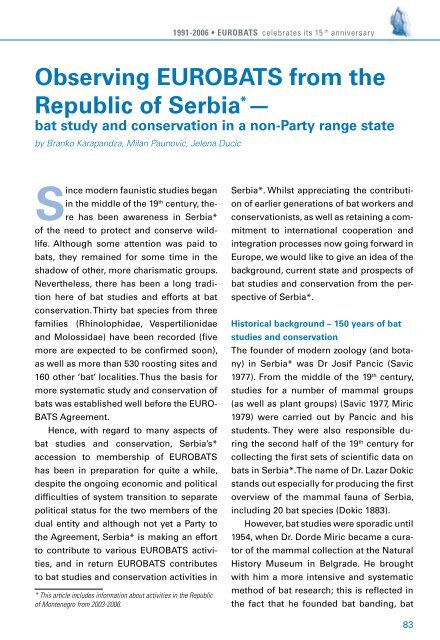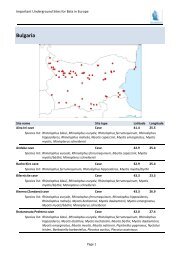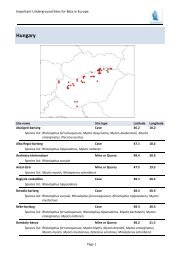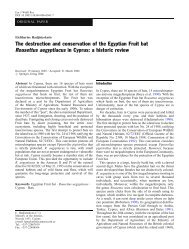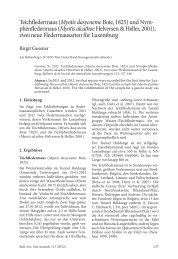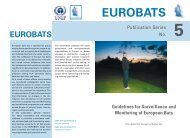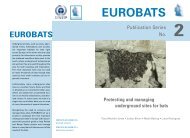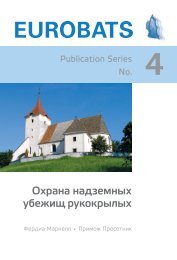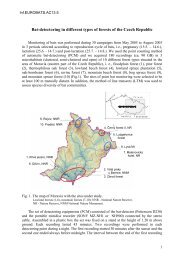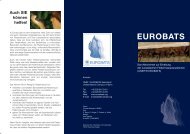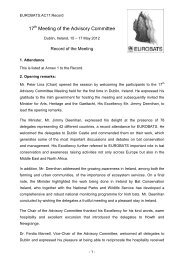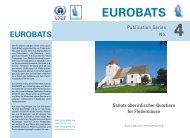1991 - 2006. EUROBATS celebrates its 15th anniversary
1991 - 2006. EUROBATS celebrates its 15th anniversary
1991 - 2006. EUROBATS celebrates its 15th anniversary
You also want an ePaper? Increase the reach of your titles
YUMPU automatically turns print PDFs into web optimized ePapers that Google loves.
<strong>1991</strong>-2006 • <strong>EUROBATS</strong> <strong>celebrates</strong> <strong>its</strong> 15 th <strong>anniversary</strong><br />
Observing <strong>EUROBATS</strong> from the<br />
*<br />
Republic of Serbia —<br />
bat study and conservation in a non-Party range state<br />
by Branko Karapandza, Milan Paunovic, Jelena Ducic<br />
Since modern faunistic studies began<br />
in the middle of the 19 th century, the-<br />
re has been awareness in Serbia<br />
of the need to protect and conserve wild-<br />
life. Although some attention was paid to<br />
bats, they remained for some time in the<br />
shadow of other, more charismatic groups.<br />
Nevertheless, there has been a long tradi-<br />
tion here of bat studies and efforts at bat<br />
conservation. Thirty bat species from three<br />
families (Rhinolophidae, Vespertilionidae<br />
and Molossidae) have been recorded (five<br />
more are expected to be confirmed soon),<br />
as well as more than 30 roosting sites and<br />
160 other ‘bat’ localities. Thus the basis for<br />
more systematic study and conservation of<br />
bats was established well before the EURO-<br />
BATS Agreement.<br />
Hence, with regard to many aspects of<br />
bat studies and conservation, Serbia’s<br />
accession to membership of <strong>EUROBATS</strong><br />
has been in preparation for quite a while,<br />
despite the ongoing economic and political<br />
difficulties of system transition to separate<br />
political status for the two members of the<br />
dual entity and although not yet a Party to<br />
the Agreement, Serbia is making an effort<br />
to contribute to various <strong>EUROBATS</strong> activities,<br />
and in return <strong>EUROBATS</strong> contributes<br />
to bat studies and conservation activities in<br />
This article includes information about activities in the Republic<br />
of Montenegro from 2003-<strong>2006.</strong><br />
Serbia . Whilst appreciating the contribution<br />
of earlier generations of bat workers and<br />
conservationists, as well as retaining a commitment<br />
to international cooperation and<br />
integration processes now going forward in<br />
Europe, we would like to give an idea of the<br />
background, current state and prospects of<br />
bat studies and conservation from the perspective<br />
of Serbia .<br />
Historical background – 150 years of bat<br />
studies and conservation<br />
The founder of modern zoology (and botany)<br />
in Serbia was Dr Josif Pancic (Savic<br />
1977). From the middle of the 19th century,<br />
studies for a number of mammal groups<br />
(as well as plant groups) (Savic 1977, Miric<br />
1979) were carried out by Pancic and his<br />
students. They were also responsible during<br />
the second half of the 19th century for<br />
collecting the first sets of scientific data on<br />
bats in Serbia . The name of Dr. Lazar Dokic<br />
stands out especially for producing the first<br />
overview of the mammal fauna of Serbia,<br />
including 20 bat species (Dokic 1883).<br />
However, bat studies were sporadic until<br />
19 4, when Dr. Dorde Miric became a curator<br />
of the mammal collection at the Natural<br />
History Museum in Belgrade. He brought<br />
with him a more intensive and systematic<br />
method of bat research; this is reflected in<br />
the fact that he founded bat banding, bat<br />
83


